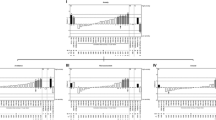Abstract
The inheritance of avoidance behavior was studied in a population of 2204 mice (Mus musculus) consisting of the inbred strains A/HeJ, BALB/cJ, SWR/J, and 129/J, and F1 and F2 generations of all their crosses and the first generation of their backcrosses. The mode of inheritance of avoidance behavior was found to be different in the two sexes. In the males it was transmitted predominantly as an overdominant trait, whereas in the females both overdominance and partial dominance were observed. Significant nonallelic interaction was found mostly in the male data, indicating that the dominance observed in the males may be inflated.
Similar content being viewed by others
References
Aksel, R., and Johnson, L. P. V. (1963). Analysis of a diallel cross: A worked example.Advancing Frontiers Plant Sci. 8:37–53.
Berlin, C. I. (1963). Hearing in mice via GSR audiometry.J. Speech Hearing Res. 6:359–368.
Berlin, C. I. (1964). Personal communication to Fuller, J. L., and Wimer, R. E. Neural, sensory, and motor functions. In Green, E. L. (ed.),Biology of the Laboratory Mouse, McGraw-Hill, New York, 1966, pp. 609–628.
Bolles, R. C. (1970). Species-specific defense reactions and avoidance learning.Psychol. Rev. 77:32–48.
Bovet, D., Bovet-Nitti, F., and Oliverio, A. (1968). Memory and consolidation mechanisms in avoidance learning of inbred mice.Brain Res. 10:168–182.
Bovet, D., Bovet-Nitti, F., and Oliverio, A. (1969). Genetic aspects of learning and memory in mice.Science 163: 139–149.
Bovet-Nitti, F., Oliverio, A., and Bovet, D. (1969). Avoidance learning in inbred BALB/c mice raised as only children or siblings.Life Sci. 8:569–574.
Carran, A. B., Yeudall, L. T., and Royce, J. R. (1964). Voltage level and skin resistance in avoidance conditioning of inbred strains of mice.J. Comp. Physiol. Psychol. 58:427–430.
Cavalli, L. L. (1952). An analysis of linkage in quantitative inheritance. In Reeve, E. C. R., and Waddington, C. H. (eds.),Quantitative Inheritance, Her Majesty's Stationery Office, London, pp. 135–144.
Collins, R. L. (1964). Inheritance of avoidance conditioning in mice: A diallel study.Science 143:1188–1190.
Crumpacker, D. W., and Allard, R. W. (1962). A diallel analysis of heading date in wheat.Hilgardia 32:275–318.
Denenberg, V. H. (1958). Effects of age and early experience upon conditioning in the C57B1/10 mouse.J. Psychol. 46:211–226.
Denenberg, V. H. (1960). A test of the critical period hypothesis and a further study of the relationship between age and conditioning in the C57B1/10 mouse.J. Genet. Psychol. 97:379–384.
Falconer, D. S. (1960).Introduction to Quantitative Inheritance, New York, Ronald Press, pp. 330–345.
Hayman, B. I. (1954a). The analysis of variance of diallel tables.Biometrics 10:235–244.
Hayman, B. I. (1954b). The theory and analysis of diallel crosses.Genetics 39:789–809.
Hayman, B. I., and Mather, K. (1955). The description of gene interaction in continuous variation.Biometrics 10:69–82.
Henderson, N. D. (1968). Genetic analysis of acquisition and retention of a conditioned fear in mice.J. Comp. Physiol. Psychol. 65:325–330.
Herrnstein, R. J. (1969). Method and theory in the study of avoidance.Psychol. Rev. 76:49–69.
Johnson, L. P. V., and Aksel, R. (1959). Inheritance of yielding capacity in a 15-parent diallel cross of barley.Can. J. Genet. Cytol. 1:208–265.
Messeri, P., Oliverio, A., and Bovet, D. (1972). Relations between avoidance and activity: A diallel study.Behav. Biol. 7:599–608.
Newell, T. G. (1970). Three biometrical genetic analyses of activity in the mouse.J. Comp. Physiol. Psychol. 70:37–47.
Oliverio, A. (1967). Effects of different conditioning schedules based on visual and acoustic conditioned stimulus on avoidance learning of two strains of mice.J. Psychol. 65:131–139.
Oliverio, A., Castellano, C., and Messeri, P. (1972). A genetic analysis of avoidance, maze and wheel running behaviors in the mouse.J. Comp. Physiol. Psychol. 79:459–473.
Rose, A., and Parsons, P. A. (1970). Behavioral studies in different strains of mice and the problem of heterosis.Genetica 41:65–87.
Royce, J. R. (1966). Optimal stimulus parameters in avoidance conditioning of inbred strains of mice.Multi. Behav. Res. 1:209–217.
Royce, J. R. (1972). Avoidance conditioning in nine strains of inbred mice using optimal stimulus parameters.Behav. Genet. 2:107–110.
Royce, J. R., Yeudall, L. T., and Poley, W. (1971). Diallel analysis of avoidance conditioning in inbred strains of mice.J. Comp. Physiol. Psychol. 76:353–358.
Royce, J. R., Poley, W. and Yeudall, L. T. (1973). Behavior-genetic analysis of mouse emotionality: I. Factor analysis.J. Comp. Physiol. Psychol. 83:36–47.
Schleidt, W. M. (1951). Töne honher Frequencz bei Mäusen.Experientia 7:65–66.
Schlesinger, K., and Wimer, R. (1967). Genotype and avoidance learning in the mouse.J. Comp. Physiol. Psychol. 63:139–141.
Seligman, M. E. P. (1970). On the generality of the laws of learning.Psychol. Rev. 77:406–418.
van Abeelen, J. H. F. (1966). Effects of genotype on mouse behavior.Anim. Behav. 14:218–225.
Wahlsten, D. (1972). Phenotypic and genetic relations between initial response to electric shock and rate of avoidance learning in mice.Behav. Genet. 2:211–240.
Wilcock, J. (1969). Gene action and behavior: An evaluation of a major gene pleiotropism.Psychol. Bull. 72:1–29.
Wimer, C. C., Wimer, R. E., and Roderick, T. H. (1971). Some behavioral differences associated with relative size of hippocampus in the mouse.J. Comp. Physiol. Psychol. 76:57–65.
Wright, S. (1952). The genetics of quantitative variability. In Reeve, E. C. R., and Waddington, C. H. (eds.),Quantitative Inheritance, Her Majesty's Stationery Office, London, pp. 5–40.
Yeudall, L. T., Royce, J. R., and DeLeeuw, M. (1968). An automatic apparatus for avoidance conditioning.Psychol. Rev. 22:139–142.
Author information
Authors and Affiliations
Additional information
This research represents an extension of a thesis submitted by the first author in partial fulfillment of the requirements for the M.Sc. degree at the University of Alberta. It was supported by National Research Council of Canada grant APA-105 to J. R. Royce and partly by grant A-4413 to R. Aksel.
Rights and permissions
About this article
Cite this article
Holmes, T.M., Aksel, R. & Royce, J.R. Inheritance of avoidance behavior inMus musculus . Behav Genet 4, 357–371 (1974). https://doi.org/10.1007/BF01066156
Received:
Accepted:
Issue Date:
DOI: https://doi.org/10.1007/BF01066156




